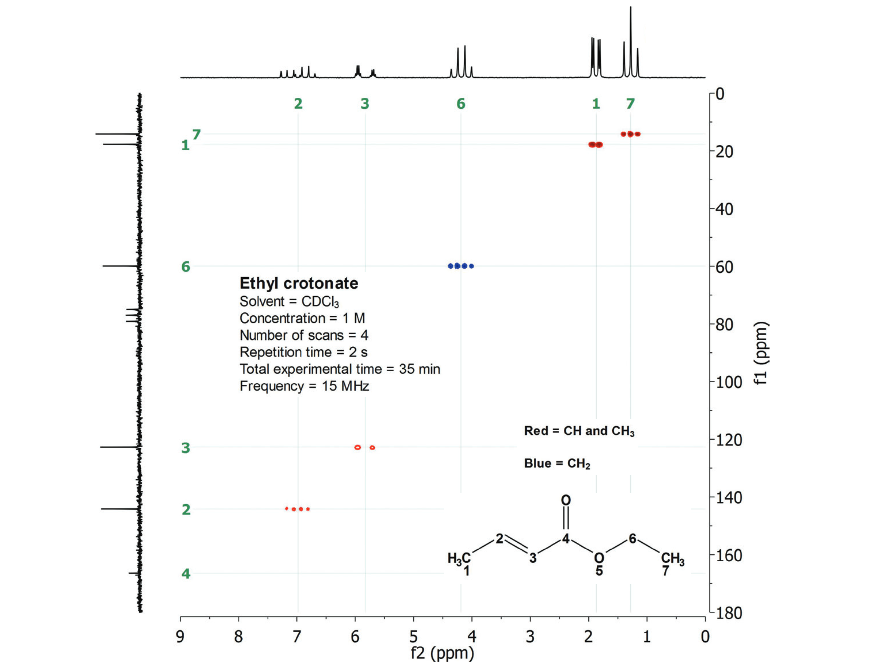INTERPRETING 2D H/C CORRELATION THROUGH ONE BOND C-H
(HMQC and/or HSQC)
It's already some 30 years since the bidimensional techniques revolutionized structural elucidation by NMR. The theory behind the recording of these spectra exceeds the goals of this course. We will however study their interpretation which is fortunately much easier.
Directly bonded 1H-13C correlate in the so-called HMQC or HSQC 2D spectra, acronyms of Heteronuclear Multiple Quantum Correlation or Heteronuclear Simple Quantum Correlation, respectively.
Less names and more examples!!!
Look at the 2D H/C of ethyl crotonate. The compound's structure in on the figure to help you understand how these spectra are interpreted.
To be honest, the utility of these spectra is to determine unknown structures but we cannot start building the house from the roof...
Please, make a list of the first features you just see:
1) There is a paralelogram and inside it some signals in red and blue.
2) In the upper part there is a conventional 1D 1H-NMR spectrum.
3) In the left hand side there is a regular 1D 13C-NMR spectrum.
4) The vertical and horizontal scales are in ppm and typical of 13C- and 1H-NMR spectra, respectively.
5) The signals in red and blue are alligned with certain signals on both axis.
Before our start deciphering the 2D spectrum, let's understand the 1D 1H- and 13C-NMR spectra.
1H-NMR:
1) The signals at 1.3 ppm (triplet) and 4.2 ppm (quartet) belong to the CH3CH2 group.
2) By applying the N+1 one understands that the CH3 shows up as a triplet (N = 2 of the neighboring CH2) and the CH2 as a quartet (N = 3 of the neighboring CH3).
3) The signal at 2.0 ppm (double-doublet) belongs to the CH3 linked to the double bond.
4) The latter CH3 couples to each of the two olefin 1H but through a different coupling constant because the distance to each of them is differen: C(1)H3-C(2)H-C(3), 3 bonds with HC(2) and 4 bonds with HC(3).
5) The signals at 6 ppm y 7.2 ppm belong to the olefin protons and they are very complex because they are coupled one another and with the CH3 group.
6) Both of the latter signals are "double-quartets": quartet due to the coupling to CH3 (N = 3) and double due to the coupling with the other olefin H (N = 1).
7) The quartets' four lines of the signal at 6 ppm are closer (lower coupling constant) to each other than in the signal at 7.2 ppm suggesting that the signal at 6 ppm belongs to the olefin H(C3) farther away from C(1)H3. The larger the distance, the lower the coupling constant.
13C-NMR:
1) There are three signals between 10 and 60 ppm that might belong to the aliphatic carbons but we cannot know which is which. Maybe the signal close to 60 ppm belongs to the carbon bonded to the electronegative oxygen.
2) The two signals between 120-140 ppm might belong to the olefin carbons but we don't know which is which either.
3) The most deshielded signal at 165 ppm should belong to the carbonyl carbon due to its high chemical shift and low intensity, the latter typical of non-hydrogenated carbons.
Let's get into the 2D H/C interpretation:
The two signals of the CH3CH2 group pair or correlate with different carbons.
The correlations are:
1.3 ppm/14 ppm
4.2 ppm/60 ppm.
The signal of the first pair is colored in red, a way the computer makes us note that this signal is antiphase to those colored in blue.
Just like what happened in the DEPT-135, don't you remember? CHx with odd x came out antiphase to CH2 groups.
The color code is arbitrary and the user may change them at will.
The correlation
1.9 ppm/18 ppm
belongs to the CH3 bonded to the olefin. It is red because it is a CHx with odd x.
The correlations
5.9 ppm/122 ppm
7.0 ppm/143 ppm
belong to the olefin CH groups, which are in red as well because they are CHx with odd x.
As we know from the 1D 1H spectrum and the value of the coupling constants, the signal at 7.0 ppm belongs to H(2), the signal at 143 ppm is automatically assigned to C(2). Hence, C(3) comes out at 122 ppm.
The interpretation was straightforward, wasn't it?
Perhaps it won't be that easy when you study an unknown compound. We'll see several examples...



